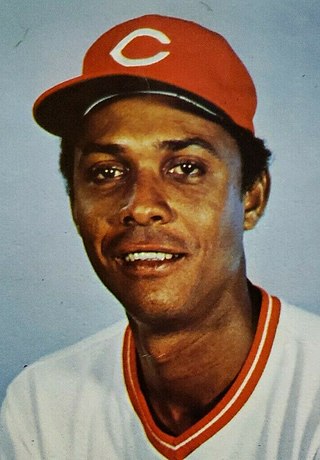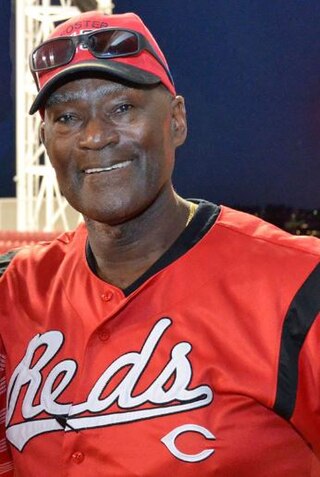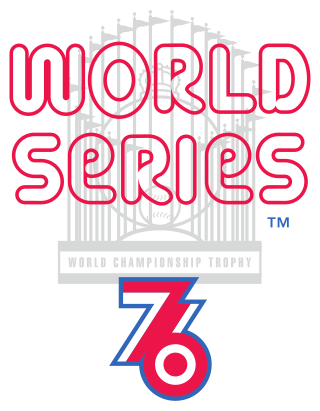
The Cincinnati Reds are an American professional baseball team based in Cincinnati. The Reds compete in Major League Baseball (MLB) as a member club of the National League (NL) Central Division and were a charter member of the American Association in 1881 before joining the NL in 1890.

Atanasio "Tony" Pérez Rigal is a Cuban-American former professional baseball player, coach and manager. He played in Major League Baseball as a first baseman and third baseman from 1964 through 1986, most notably as a member of the Cincinnati Reds dynasty that won four National League pennants and two World Series championships between 1970 and 1976. He also played for the Montreal Expos, Boston Red Sox and the Philadelphia Phillies.

The 1975 World Series was the championship series of Major League Baseball's (MLB) 1975 season. The 72nd edition of the World Series, it was a best-of-seven playoff played between the American League (AL) champion Boston Red Sox and the National League (NL) champion Cincinnati Reds. The Reds won the series, four games to three. In 2003, ESPN ranked it the second-greatest World Series ever played, trailing only the 1991 series, while in 2020, Sam Miller of ESPN named it the best World Series ever.

David Ismael Concepción Benitez is a Venezuelan former professional baseball player and manager. He played his entire career in Major League Baseball as a shortstop for the Cincinnati Reds dynasty that won four National League pennants and two World Series championships between 1970 and 1976.

George Arthur Foster is an American former professional baseball player and scout. He played in Major League Baseball as an outfielder from 1969 through 1986, most notably as an integral member of the Cincinnati Reds, with whom he won two World Series championships, in 1975 and 1976. He also played for the San Francisco Giants, New York Mets and the Chicago White Sox.

The 1976 World Series was the championship series of Major League Baseball's (MLB) 1976 season. The 73rd edition of the World Series, it was a best-of-seven playoff played between the National League (NL) champion Cincinnati Reds and the American League (AL) champion New York Yankees. The Reds swept the Series in four games to repeat as champions, avenging their 1939 and 1961 World Series losses to the Yankees. The 1976 Reds became, and remain, the only team to sweep an entire multi-tier postseason, one of the crowning achievements of the franchise's Big Red Machine era. They also became the third NL team to win consecutive World Series, and remain the last to do so.

Lee Andrew May was an American professional baseball player and coach. He played in Major League Baseball (MLB) as a first baseman and designated hitter from 1965 to 1982 for the Cincinnati Reds, Houston Astros, Baltimore Orioles, and Kansas City Royals.
Robert Lee Howsam was an American professional sports executive and entrepreneur. In 1959, he played a key role in establishing two leagues—the American Football League, which succeeded and merged with the National Football League, and baseball's Continental League, which never played a game but forced expansion of Major League Baseball (MLB) from 16 to 20 teams in 1961–62. Howsam then became a prominent MLB executive as the highly successful general manager (GM) and club president of the Cincinnati Reds during the Big Red Machine dynasty between 1967 and 1977, when his team won four National League pennants and two World Series titles. He also served as GM of the St. Louis Cardinals from August 17, 1964, until January 22, 1967, where he inherited a team that would win the 1964 World Series, but made material contributions to the Redbirds' 1967 world champions and 1968 pennant-winners.

Robert Douglas Flynn Jr. is an American former professional baseball player. He played in Major League Baseball (MLB) from 1975 to 1985 as an infielder for the Cincinnati Reds, New York Mets, Texas Rangers, Montreal Expos and the Detroit Tigers. Flynn was a member of two world championship winning teams with the Cincinnati Reds and won a Gold Glove Award in 1980 as a member of the New York Mets.
The Cincinnati Reds, a Major League Baseball team, were originally members of the American Association from 1882 to 1889; the team has played in the National League ever since, being one of only five 19th-century teams still playing in its original city.

Dale Albert Murray is an American former Major League Baseball pitcher.

The 2000 Cincinnati Reds season was the 131st season for the franchise in Major League Baseball. It consisted of the Cincinnati Reds attempting to win the National League Central, although coming short in second place. They had a record of 85 wins and 77 losses. The Reds became only the second team in the modern era of baseball not be shut out for an entire season, joining the 1932 New York Yankees. The 2020 Los Angeles Dodgers later accomplished this feat, but their season was shortened to 60 games due to the COVID-19 pandemic.
The Cincinnati Reds' 1989 season was one of the most turbulent in the team's history. The season was defined by allegations of gambling by Pete Rose. Before the end of the season, Rose was banned from baseball by commissioner A. Bartlett Giamatti.
The Cincinnati Reds' 1988 season marked the last of four consecutive winning seasons for the Reds, all of which resulted in second place finishes in the National League West. Led by manager Pete Rose, the Reds finished with the best record of these four seasons at 87 wins and 74 losses, but finished seven games back of the eventual World Series champion Los Angeles Dodgers. The 1988 season would be Pete Rose's last full season as Reds manager.
The 1977 Cincinnati Reds season was a season in American baseball. The team finished in second place in the National League West, with a record of 88–74, 10 games behind the Los Angeles Dodgers. The Reds were managed by Sparky Anderson and played their home games at Riverfront Stadium.
The 1976 Cincinnati Reds season was a season in American baseball. The Reds entered the season as the reigning World Series champions. The Reds dominated the league all season and won their second consecutive National League West title with a record of 102–60, finishing ten games ahead of the Los Angeles Dodgers. With the best record in baseball, they went on to defeat the Philadelphia Phillies in the NLCS in three straight games to reach the World Series. They proceeded to win the title in four straight games over the New York Yankees. They were the third and most recent National League team to achieve this distinction, and the first since the 1921–22 New York Giants. The Reds drew 2,629,708 fans to their home games at Riverfront Stadium, an all-time franchise attendance record. As mentioned above, the Reds swept through the entire postseason with their sweeps of the Phillies and Yankees, achieving a record of 7-0. As of 2024, the Reds are the only team in baseball history to sweep through an entire postseason in the divisional era.
The 1975 Cincinnati Reds season was a season in American baseball. The Reds dominated the league all season, and won the National League West with a record of 108–54, the best record in MLB and finished 20 games ahead of the Los Angeles Dodgers. The Reds went on to win the NLCS by defeating the Pittsburgh Pirates in three straight games, and the World Series in seven games over the Boston Red Sox. The Reds were managed by Sparky Anderson and played their home games at Riverfront Stadium. It was the first World Series championship for Cincinnati since 1940. The 1975 Reds are one of the few teams to consistently challenge the 1927 New York Yankees for the title of the best team in major league history. The Reds went 64–17 at home in 1975, which remains the best home record ever by a National League team. It is currently the second-best home record in MLB history, behind the 1961 Yankees, who went 65-16.
The 1973 Cincinnati Reds season consisted of the Reds winning the National League West with a Major League-best record of 99–63, 3+1⁄2 games ahead of the Los Angeles Dodgers, before losing the NLCS to the New York Mets in five games. The Reds were managed by Sparky Anderson, and played their home games at Riverfront Stadium.
The 1972 Cincinnati Reds season consisted of the Reds winning the National League West title with a record of 95 wins and 59 losses, 10+1⁄2 games over the Houston Astros and the Los Angeles Dodgers. They defeated the previous year's World Series Champion Pittsburgh Pirates in the NLCS, but lost to the Oakland Athletics in seven games in the World Series. The Reds were managed by Sparky Anderson.
The 1970 Cincinnati Reds season consisted of the Reds winning the National League West title with a record of 102 wins and 60 losses, 14+1⁄2 games ahead of the Los Angeles Dodgers. The Reds defeated the Pittsburgh Pirates in three straight games in the NLCS to win their first National League pennant since 1961. The team then lost to the Baltimore Orioles in the World Series in five games.











